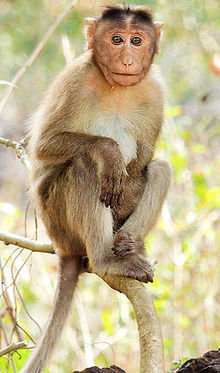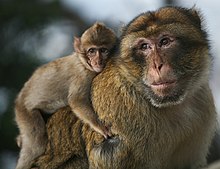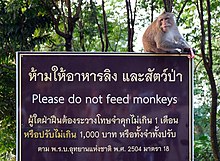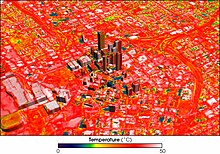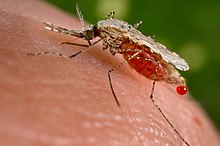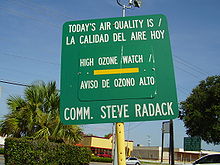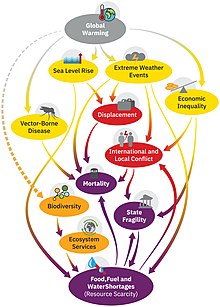From Wikipedia, the free encyclopedia
The effects of climate change on human health are increasingly well studied and quantified.They fall into three main categories: (i) direct effects (e.g. due to heat waves, extreme weather
events), (ii) impacts from climate-related changes in ecological
systems and relationships (e.g. crop yields, marine productivity), and
(iii) the more indirect consequences such as impoverishment,
displacement, and mental health problems.
More specifically, the relationship between health and heat includes the following main aspects: exposure of vulnerable populations to heatwaves, heat-related mortality, reduced labour capacity for outdoor workers and impacts on mental health. There is a range of climate-sensitive infectious diseases which may increase in some regions, such as mosquito-borne diseases, cholera and some waterborne diseases. Health is also acutely impacted by extreme weather events (floods, hurricanes, droughts, wildfires) through injuries, diseases, and air pollution in the case of wildfires. Other indirect health impacts from climate change may be rising food insecurity, undernutrition and water insecurity.
Climate change will also impact where diseases are moving in the
future. Many infectious diseases are predicted to spread to new
geographic areas with naïve immune systems.
Disadvantaged populations are especially vulnerable to climate change impacts. For example, young children and older people are the most vulnerable to extreme heat.
The health effects of climate change are increasingly a matter of concern for the international public health policy community. Already in 2009, a publication in the well-known general medical journal The Lancet stated: "Climate change is the biggest global health threat of the 21st century". This was re-iterated in 2015 by a statement of the World Health Organisation. In 2019, the Australian Medical Association formally declared climate change a health emergency.
Studies have found that communication on climate change is more
likely to lead to engagement by the public if it is framed as a health
concern, rather than just as an environmental matter.
Background
Effects of climate change
Climate change affects the physical environment, ecosystems and human societies. Changes in the climate system
include an overall warming trend, more extreme weather and rising sea
levels. These in turn impact nature and wildlife, as well as human
settlements and societies. The effects of human-caused climate change are broad and far-reaching, especially if significant climate action is not taken. The projected and observed negative impacts of climate change are sometimes referred to as the climate crisis.
The changes in climate are not uniform across the Earth. In
particular, most land areas have warmed faster than most ocean areas,
and the Arctic is warming faster than most other regions. Among the effects of climate change on oceans are an increase of ocean temperatures, a rise in sea level from ocean warming and ice sheet melting, increased ocean stratification, and changes to ocean currents including a weakening of the Atlantic meridional overturning circulation. Carbon dioxide from the atmosphere is acidifiying the ocean.
Recent warming has strongly affected natural biological systems. It has
degraded land by raising temperatures,
drying soils and increasing
wildfire risk.
Species worldwide are migrating poleward to colder areas. On land, many
species move to higher ground, whereas marine species seek colder water
at greater depths. At 2 °C (3.6 °F) of warming, around 10% of species on land would become
critically endangered.
Climate change vulnerability
A 2021 report published in The Lancet
found that climate change does not affect people's health in an equal
way. The greatest impact tends to fall on the most vulnerable such as
the poor, women, children, the elderly, people with pre-existing health
concerns, other minorities and outdoor workers.
There are certain predictors for health patterns of people which
will determine the social vulnerability of the individuals. These can be
grouped into "demographic, socioeconomic, housing, health (such as
pre-existing health conditions), neighbourhood, and geographical
factors".
Types of pathways affecting health
Illustration for the effect of climate change on human health
Climate change is linked with health outcomes via three main pathways:
- Direct mechanisms or risks: changes in extreme weather and
resultant increased storms, floods, droughts, heat waves (wildfires also
fit here)
- Indirect mechanisms or risks: these are mediated through changes in the biosphere (e.g., in the burden of disease and distribution of disease vectors, or food availability, water quality, air pollution, land use change, ecological change)
- Social dynamics (age and gender, health status, socioeconomic status, social capital, public health infrastructure, mobility and conflict status)
These health risks vary across the world. For example, differences in
health service provision or economic development will result in
different health risks for people in different regions.
Overview of health impacts
General health impacts
The direct, indirect and social dynamic effects of climate change on health and wellbeing produce the following health impacts: cardiovascular diseases, respiratory diseases, infectious diseases, undernutrition, mental illness, allergies, injuries and poisoning.
Health and health care provision can also be impacted by the collapse of health systems due to climate-induced events such as flooding. Therefore, building health systems that are climate resilient is a priority.
Mental health impacts
The effects of climate change on mental health and well-being can be negative, especially for vulnerable populations and those with pre-existing serious mental illness. There are three broad pathways by which these effects can take place: directly, indirectly or via awareness. The direct pathway includes stress related conditions being caused by exposure to extreme weather events, such as post-traumatic stress disorder
(PTSD). Scientific studies have linked mental health outcomes to
several climate-related exposures—heat, humidity, rainfall, drought,
wildfires and floods.
The indirect pathway can be via disruption to economic and social
activities, such as when an area of farmland is less able to produce
food.
The third pathway can be of mere awareness of the climate change
threat, even by individuals who are not otherwise affected by it.
Mental health outcomes have been measured in several studies through indicators such as psychiatric hospital admissions, mortality, self-harm and suicide rates. Vulnerable populations and life stages include people with pre-existing mental illness, Indigenous peoples, children and adolescents. The emotional responses to the threat of climate change can include eco-anxiety, ecological grief and eco-anger. Such emotions can be rational responses to the degradation of the natural world and lead to adaptive action.
Assessing the exact mental health effects of climate change is
difficult; increases in heat extremes pose risks to mental health which
can manifest themselves in increased mental health-related hospital
admissions and
suicidality.
Impacts caused by heat
Impacts of higher global temperatures will have ramifications for the following aspects: vulnerability to extremes of heat, exposure of vulnerable populations to heatwaves, heat and physical activity, change in labor capacity, heat and sentiment (mental health), heat-related mortality.
The global average and combined land and ocean surface temperature
show a warming of 1.09 °C (range: 0.95 to 1.20 °C) from 1850–1900 to
2011–2020, based on multiple independently produced datasets. The trend is faster since 1970s than in any other 50-year period over at least the last 2000 years.
Heat-related health impacts for vulnerable people
Vulnerable people with regard to heat illnesses
include people with low incomes, minority groups, women (in particular
pregnant women), children, older adults (over 65 years old), people with
chronic diseases, disabilities and co-morbidities. Further people at risk include those in urban environments (due to the urban heat island effect), outdoor workers and people who take certain prescription drugs. Exposure to extreme heat poses an acute health hazard for many of the people deemed as vulnerable.
Climate change increases the frequency and severity of heatwaves and thus heat stress for people. Human responses to heat stress can include heat stroke and hyperthermia. Extreme heat is also linked to low quality sleep, acute kidney injury and complications with pregnancy. Furthermore, it may cause the deterioration of pre-existing cardiovascular and respiratory disease. Adverse pregnancy outcomes due to high ambient temperatures include for example low birth weight and pre-term birth. Heat waves have also resulted in epidemics of chronic kidney disease (CKD). Prolonged heat exposure, physical exertion, and dehydration are sufficient factors for the development of CKD.
The human body requires evaporative cooling to prevent
overheating, even with a low activity level. With excessive ambient heat
and humidity during heatwaves, adequate evaporative cooling might be compromised.
A wet-bulb temperature that is too high means that human bodies would no longer be able to adequately cool the skin.
A wet bulb temperature of 35 °C is regarded as the limit for humans
(called the "physiological threshold for human adaptability" to heat and
humidity).
As of 2020, only two weather stations had recorded 35 °C wet-bulb
temperatures, and only very briefly, but the frequency and duration of
these events is expected to rise with ongoing climate change. Global warming above 1.5 degrees risks making parts of the tropics uninhabitable because the threshold for the wet bulb temperature may be passed.
People with cognitive health issues (e.g. depression, dementia, Parkinson's disease) are more at risk when faced with high temperatures and ought to be extra careful. as cognitive performance has been shown to be differentially affected by heat.
People with diabetes, are overweight, have sleep deprivation, or have
cardiovascular/cerebrovascular conditions should avoid too much heat
exposure.
The risk of dying from chronic lung disease during a heat wave
has been estimated at 1.8-8.2% higher compared to average summer
temperatures.
An 8% increase in hospitalization rate for people with COPD has been
estimated for every 1 °C increase in temperatures above 29 °C.
In urban areas
The effects of heatwaves tend to be more pronounced in urban areas
because they are typically warmer than surrounding rural areas due to
the urban heat island effect.
This is caused from the way many cities are built. For example, they
often have extensive areas of asphalt, reduced greenery along with many
large heat-retaining buildings that physically block cooling breezes and
ventilation. Lack of water features are another cause.
Extreme heat exposure in cities with a wet bulb globe temperature above 30 °C tripled between 1983 and 2016. It increased by about 50% when the population growth in these cities is not taken into account.
Cities are often on the front-line of climate impacts due to
their densely concentrated populations, the urban heat island effect,
their frequent proximity to coasts and waterways, and reliance on ageing
physical infrastructure networks.
Heat-related mortality
Health experts warn that "exposure to extreme heat increases the risk of death from cardiovascular, cerebrovascular, and respiratory conditions
and all-cause mortality. Heat-related deaths in people older than 65
years reached a record high of an estimated 345 000 deaths in 2019".
More than 70,000 Europeans died as a result of the 2003 European heat wave. Also more than 2,000 people died in Karachi, Pakistan in June 2015 due to a severe heat wave with temperatures as high as 49 °C (120 °F).
Increasing access to indoor cooling (air conditioning)
will help prevent heat-related mortality but current air conditioning
technology is generally unsustainable as it contributes to greenhouse gas emissions, air pollution, peak electricity demand, and urban heat islands.
Mortality due to heat waves could be reduced if buildings were
better designed to modify the internal climate, or if the occupants were
better educated about the issues, so they can take action on time. Heatwave early warning and response systems are important elements of heat action plans.
Reduced labour capacity
Heat exposure can affect people's ability to work. The annual Countdown Report by The Lancet investigated change in labour capacity
as an indicator. It found that during 2021, high temperature reduced
global potential labour hours by 470 billion - a 37% increase compared
to the average annual loss that occurred during the 1990s. Occupational
heat exposure affects especially laborers in the agricultural sector of developing countries. In those countries, the vast majority of these labour hour losses (87%) were in the agricultural sector.
Working in extreme heat can lead to labor force productivity
decreases as well as participation because employees' health may be
weaker due to heat related health problems, such as dehydration,
fatigue, dizziness, and confusion.
Sports and outdoor exercise
With regards to sporting activities it has been observed that "hot weather reduces the likelihood of engaging in exercise" Furthermore, participating in sports during excessive heat can lead to injury or even death. It is also well established that regular physical activity is beneficial for human health, including mental health. Therefore, an increase in hot days due to climate change could indirectly affect mental health due to people exercising less.
However, the evidence on hours of outdoor exercise is still weak:
A review in 2021 reported data on the increase of hours per year during
which temperatures were too high for safe outdoor exercise (Indicator
1.1.3).
But the follow-up review in the following year did not report the same
kind of data but reported an increase in "hours of moderate risk of heat
stress during light outdoor physical activity".
Impacts caused by weather and climate events other than heat
Climate change is increasing the periodicity and intensity of some extreme weather events. Confidence in the attribution of extreme weather
to anthropogenic climate change is highest in changes in frequency or
magnitude of extreme heat and cold events with some confidence in
increases in heavy precipitation and increases in the intensity of
droughts.
Extreme weather events, such as floods, hurricanes, droughts and wildfires can result in injuries, death and the spread of infectious diseases. For example, local epidemics can occur due to loss of infrastructure, such as hospitals and sanitation services, but also because of changes in local ecology and environment.
Floods
Due to an increase in heavy rainfall events, floods are expected to become more severe in future when they do occur.
However, the interactions between rainfall and flooding are complex.
There are in fact some regions in which flooding is expected to become
rarer. This depends on several factors, such as changes in rain and
snowmelt, but also soil moisture. Floods have short and long-term negative implications to people's health and well-being. Short term implications include mortalities, injuries and diseases, while long term implications include non-communicable diseases and psychosocial health aspects.
For example, in the 2022 Pakistan Floods (which were likely more severe because of climate change)
people's health was affected through various direct and indirect ways.
There were outbreaks of diseases like malaria, dengue, and other skin
diseases.
Hurricanes and thunderstorms
Stronger hurricanes create more opportunities for vectors to breed and infectious diseases to flourish. Extreme weather
also means stronger winds. These winds can carry vectors tens of
thousands of kilometers, resulting in an introduction of new infectious
agents to regions that have never seen them before, making the humans in
these regions even more susceptible.
Another result of hurricanes is increased rainwater, which
promotes flooding. Hurricanes result in ruptured pollen grains, which
releases respirable aeroallergens. Thunderstorms cause a concentration
of pollen grains at the ground level, which causes an increase in the
release of allergenic particles in the atmosphere due to rupture by
osmotic shock. Around 20–30 minutes after a thunderstorm, there is an
increased risk for people with pollen allergies to experience severe
asthmatic exacerbations, due to high concentration inhalation of
allergenic peptides.
Droughts
Climate change affects multiple factors associated with droughts, such as how much rain falls and how fast the rain evaporates again. Warming over land increases the severity and frequency of droughts around much of the world. Many of the consequences of droughts have impacts on human health. This can be through destruction of food supply (loss of crop yields), malnutrition and with this, dozens of associated diseases and health problems.
Wildfires
Air pollution from a surface fire in the western desert of
Utah.
Wildfires become more frequent and intense due to climate change.
Climate change increases wildfire potential and activity. Climate change leads to a warmer ground temperature and its effects include earlier snowmelt dates, drier than expected vegetation, increased number of potential fire days, increased occurrence of summer droughts, and a prolonged dry season.
Wood smoke from wildfires produces particulate matter that has damaging effects to human health. The primary pollutants in wood smoke are carbon monoxide and nitric oxide. Through the destruction of forests and human-designed infrastructure, wildfire smoke releases other toxic and carcinogenic compounds, such as formaldehyde and hydrocarbons. These pollutants damage human health by evading the mucociliary clearance system and depositing in the upper respiratory tract, where they exert toxic effects.
The health effects of wildfire smoke exposure include exacerbation and development of respiratory illness such as asthma and chronic obstructive pulmonary disorder; increased risk of lung cancer, mesothelioma and tuberculosis; increased airway hyper-responsiveness; changes in levels of inflammatory mediators and coagulation factors; and respiratory tract infection.
Health risks due to climate-sensitive infectious diseases
Infectious diseases that are sensitive to climate can be grouped into: vector-borne diseases (transmitted via mosquitos, ticks etc.), water-borne diseases and food-borne diseases. Climate change is affecting the distribution of all these diseases. This occurs for example via expanding the geographic range and seasonality of these diseases and their vectors.
Climate change may also lead to new infectious diseases due to
changes in microbial and vector geographic range. Microbes that are
harmful to humans can adapt to higher temperatures, which will allow
them to build better tolerance against human endothermy defenses.
Vector-borne diseases
An
Anopheles stephensi
mosquito shortly after obtaining blood from a human (the droplet of
blood is expelled as a surplus). This mosquito is a vector of
malaria, and mosquito control is an effective way of reducing its incidence.
Mosquito-borne diseases
Mosquito-borne diseases that are sensitive to climate include for example malaria, elephantiasis, Rift Valley fever, yellow fever, dengue fever, Zika virus, and chikungunya.
Scientists found in 2022 that rising temperatures are increasing the
areas where dengue fever, malaria and other mosquito-carried diseases
are able to spread.
Warmer temperatures are also advancing to higher elevations, allowing
mosquitoes to survive in places that were previously inhospitable to
them. This risks malaria making a return to areas where it was previously eradicated.
Diseases from ticks
Ticks are changing their geographic range because of rising temperatures, and this puts new populations at risk. Ticks can spread lyme disease and tick-borne encephalitis. It is expected that climate change will increase the incidence of these diseases in the Northern Hemisphere.
For example, a review of the literature found that "In the USA, a 2°C
warming could increase the number of Lyme disease cases by over 20% over
the coming decades and lead to an earlier onset and longer length of
the annual Lyme disease season".
Waterborne diseases
There are a range of waterborne diseases and parasites that will pose greater health risks in future. This will vary by region. For example, in Africa Cryptosporidium spp. and Giardia duodenalis (two protozoan parasites) will increase. This is due to increasing temperatures and drought.
Scientist expect that disease outbreaks caused by vibrio (in particular the bacterium that causes cholera, which is called vibrio cholerae) are increasing in occurrence and intensity. One reason is that the area of coastline with suitable conditions for vibrio bacteria has increased due to changes in sea surface temperature and sea surface salinity caused by climate change. These pathogens can cause gastroenteritis, cholera, wound infections, and sepsis.
It has been observed that in the period of 2011–21, the "area of
coastline suitable for Vibrio bacterial transmission has increased by
35% in the Baltics, 25% in the Atlantic Northeast, and 4% in the Pacific Northwest.
Furthermore, the increasing occurrence of higher temperature days,
heavy rainfall events and flooding due to climate change could lead to
an increase in cholera risks.
Other health risks influenced by climate change
Harmful algal blooms in oceans and lakes
Cyanobacteria (blue-green algae) bloom on
Lake Erie (United States) in 2009. These kinds of algae can cause harmful algal blooms.
The warming oceans and lakes are leading to more frequent harmful algal blooms. Also, during droughts, surface waters are even more susceptible to harmful algal blooms and microorganisms. Algal blooms increase water turbidity, suffocating aquatic plants, and can deplete oxygen, killing fish. Some kinds of blue-green algae (cyanobacteria) create neurotoxins,
hepatoxins, cytotoxins or endotoxins that can cause serious and
sometimes fatal neurological, liver and digestive diseases in humans.
Cyanobacteria grow best in warmer temperatures (especially above 25
degrees Celsius), and so areas of the world that are experiencing
general warming as a result of climate change are also experiencing
harmful algal blooms more frequently and for longer periods of time.
One of these toxin producing algae is Pseudo-nitzschia fraudulenta. This species produces a substance called domoic acid which is responsible for amnesic shellfish poisoning. The toxicity of this species has been shown to increase with greater CO2 concentrations associated with ocean acidification. Some of the more common illnesses reported from harmful algal blooms include; Ciguatera fish poisoning, paralytic shellfish poisoning, azaspiracid shellfish poisoning, diarrhetic shellfish poisoning, neurotoxic shellfish poisoning and the above-mentioned amnesic shellfish poisoning.
Ozone-related health burden
The relationship between surface ozone (also called ground-level ozone)
and ambient temperature is complex. Changes in air temperature and
water content affect the air's chemistry and the rates of chemical
reactions that create and remove ozone. Many chemical reaction rates
increase with temperature and lead to increased ozone production.
Climate change projections show that rising temperatures and water
vapour in the atmosphere will likely increase surface ozone in polluted
areas like the eastern United States.
On the other hand, ozone concentrations could decrease in a
warming climate if anthropogenic ozone-precursor emissions (e.g.,
nitrogen oxides) continue to decrease through implementation of policies
and practices.
Therefore, future surface ozone concentrations depend on the climate
change mitigation steps taken (more or less methane emissions) as well
as air pollution control steps taken.
High surface ozone concentrations often occur during heat waves in the United States.
Throughout much of the eastern United States, ozone concentrations
during heat waves are at least 20% higher than the summer average. Broadly speaking, surface ozone levels are higher in cities with high levels of air pollution.
Ozone pollution in urban areas affects denser populations, and is
worsened by high populations of vehicles, which emit pollutants NO2 and VOCs, the main contributors to problematic ozone levels.
There is a great deal of evidence to show that surface ozone can harm lung function and irritate the respiratory system. Exposure to ozone (and the pollutants that produce it) is linked to premature death, asthma, bronchitis, heart attack, and other cardiopulmonary problems. High ozone concentrations irritate the lungs and thus affect respiratory function, especially among people with asthma.
People who are most at risk from breathing in ozone air pollution are
those with respiratory issues, children, older adults and those who
typically spend long periods of time outside such as construction
workers.
Carbon dioxide levels and human cognition
Higher levels of indoor and outdoor CO2 levels may impair human cognition.
Pollen allergies
Depiction of a person suffering from Allergic Rhinitis
A warming climate can lead to increases of pollen season
lengths and concentrations in some regions of the world. For example,
in northern mid-latitudes regions, the spring pollen season is now
starting earlier. This can affect people with pollen allergies (hay fever). The rise in pollen also comes from rising CO2 concentrations in the atmosphere and resulting CO2 fertilisation effects.
Violence and conflicts
Climate change may increase the risk of violent conflict, which can lead to injuries, such as battle injuries,
and death. Conflict can result from the increased propensity towards
violence after people become more irritable due to excessive heat.
There can also be follow-on effects on health from resource scarcity
or human migrations that climate change can cause or aggravate in
already conflict prone areas.
However, the observed contribution of climate change to conflict
risk is small in comparison with cultural, socioeconomic, and political
causes. There is some evidence that rural-to-urban migration
within countries worsens the conflict risk in violence prone regions.
But there is no evidence that migration between countries would increase
the risk of violence.
Accidents
Researchers found that there is a strong correlation between higher winter temperatures and drowning accidents in large lakes, because the ice gets thinner and weaker.
Available evidence on the effect of climate change on the epidemiology of snakebite
is limited but it is expected that there will be a geographic shift in
risk of snakebite: northwards in North America and southwards in South
America and in Mozambique, and increase in incidence of bite in Sri
Lanka.
Health risks from food and water insecurity
Climate change affects many aspects of food security through "multiple and interconnected pathways". Many of these are related to the effects of climate change on agriculture,
for example failed crops due to more extreme weather events. This comes
on top of other coexisting crises that reduce food security in many
regions. Less food security means more undernutrition
with all its associated health problems. Food insecurity is increasing
at the global level (some of the underlying causes are related to
climate change, others are not) and about 720–811 million people
suffered from hunger in 2020.
The number of deaths resulting from climate change-induced changes to food availability are difficult to estimate. The 2022 IPCC Sixth Assessment Report does not quantify this number in its chapter on food security.
A modelling study from 2016 found "a climate change–associated net
increase of 529,000 adult deaths worldwide [...] from expected
reductions in food availability (particularly fruit and vegetables) by
2050, as compared with a reference scenario without climate change."
Reduced nutritional value of crops
Changes in atmospheric
carbon dioxide may reduce the
nutritional quality of some crops, with for instance wheat having less protein and less of some minerals. The nutritional quality of
C3 plants
(e.g. wheat, oats, rice) is especially at risks: lower levels of
protein as well as minerals (for example zinc and iron) are expected.
Food crops could see a reduction of
protein,
iron and
zinc content in common food crops of 3 to 17%. This is the projected result of food grown under the expected atmospheric carbon-dioxide levels of 2050. Using data from the
UN Food and Agriculture Organization as well as other public sources, the authors analyzed 225 different staple foods, such as
wheat,
rice,
maize,
vegetables, roots and
fruits.
Food production from the oceans
A headline finding in 2021 regarding marine food security stated
that: "In 2018–20, nearly 70% of countries showed increases in average
sea surface temperature in their territorial waters compared within
2003–05, reflecting an increasing threat to their marine food
productivity and marine food security".
Water insecurity
Aggregated
global water security index, calculated using the aggregation of water
availability, accessibility, safety and quality, and management indices.
The value ‘0–1’ (with the continuous color ‘red to blue’) represents
‘low to high’ security.
Access to clean drinking water and sanitation is important for healthy living and well-being.
Water resources can be affected by climate change in various ways. The total amount of
freshwater available can change, for instance due to
dry spells or droughts. Heavy rainfall and flooding can have an impact on
water quality:
pollutants can be transported into water bodies by the increased
surface runoff.
In coastal regions, more salt may find its way into water resources due
to higher sea levels and more intense storms. Higher temperatures also
directly degrade water quality: warm water contains less oxygen. Changes in the
water cycle
threaten existing and future water infrastructure. It will be harder to
plan investments for water infrastructure as there are significant
uncertainties about future variability of the water cycle.
Potential health benefits
Health co-benefits from mitigation
The health benefits (also called "co-benefits") from climate change mitigation
measures are significant: potential measures can not only mitigate
future health impacts from climate change but also improve health
directly. Climate change mitigation is interconnected with various co-benefits (such as reduced air pollution and associated health benefits)
and how it is carried out (in terms of e.g. policymaking) could also
determine its impacts on living standards (whether and how inequality
and poverty are reduced).
There are many health co-benefits associated with climate action.
These include those of cleaner air, healthier diets (e.g. less red
meat), more active lifestyles, and increased exposure to green urban
spaces. Access to urban green spaces provides benefits to mental health as well.
Compared with the current pathways scenario
(with regards to greenhouse gas emissions and mitigation efforts), the
"sustainable pathways scenario" will likely result in an annual
reduction of 1.18 million air pollution-related deaths, 5.86 million
diet-related deaths, and 1.15 million deaths due to physical inactivity,
across the nine countries, by 2040. These benefits were attributable to
the mitigation of direct greenhouse gas emissions and the commensurate
actions that reduce exposure to harmful pollutants, as well as improved
diets and safe physical activity. Air pollution generated by fossil fuel combustion is both a major driver of global warming and the cause of a large number of annual deaths with some estimates as high as excess deaths during 2018.
Placing health as a key focus of the Nationally Determined Contributions could present an opportunity to increase ambition and realize health co-benefits.
Potential health benefits from global warming
It is possible that a potential health benefit from global warming could result from fewer cold days in winter: This could lead to some mental health benefits. However, the evidence on this correlation is regarded as inconsistent in 2022.
Global estimates
Simplified conceptual causal loop diagram of cascading global climate failure, related to the concept of
One Health[111]Estimating deaths (mortality) or DALYs (morbidity) from the effects of climate change at the global level is very difficult. A 2014 study by the World Health Organization tried to do this and estimated the effect of climate change on human health, but not all of the effects of climate change were included in their estimates.
For example, the effects of more frequent and extreme storms were
excluded. They did assess deaths from heat exposure in elderly people,
increases in diarrhea, malaria, dengue, coastal flooding,
and childhood undernutrition. The authors estimated that climate change
was projected to cause an additional 250,000 deaths per year between
2030 and 2050 but also stated that "these numbers do not represent a
prediction of the overall impacts of climate change on health, since we
could not quantify several important causal pathways".
Climate change was responsible for 3% of diarrhoea, 3% of malaria, and 3.8% of dengue fever deaths worldwide in 2004.
Total attributable mortality was about 0.2% of deaths in 2004; of
these, 85% were child deaths. The effects of more frequent and extreme
storms were excluded from this study.
The health impacts of climate change are expected to rise in line with projected ongoing global warming for different climate change scenarios.
Society and culture
Climate justice and climate migrants
Much of the health burden associated with climate change falls on vulnerable people (e.g. indigenous peoples
and economically disadvantaged communities). As a result, people of
disadvantaged sociodemographic groups experience unequal risks.
Often these people will have made a disproportionately low contribution
toward man-made global warming, thus leading to concerns over climate justice.
Climate change has diverse impacts on migration activities, and
can lead to decreases or increases in the number of people who migrate. Migration activities can have impacts on health and well-being, in particular for mental health. Migration in the context of climate change can be grouped into four types: adaptive migration (see also climate change adaptation),
involuntary migration, organised relocation of populations, and
immobility (which is when people are unable or unwilling to move even
though it is recommended).
Communication strategies
Studies have found that when communicating climate change with the public,
it can help encourage engagement if it is framed as a health concern,
rather than as an environmental issue. This is especially the case when
comparing a health related framing to one that emphasised environmental
doom, as was common in the media at least up until 2017. Communicating the co-benefits to health helps underpin greenhouse gas reduction strategies. Safeguarding health—particularly of the most vulnerable—is a frontline local climate change adaptation goal.
Policy responses
Due to its significant impact on human health, climate change has become a major concern for public health policy. The United States Environmental Protection Agency had issued a 100-page report on global warming and human health back in 1989. By the early years of the 21st century, climate change was increasingly
addressed as a public health concern at a global level, for example in
2006 at Nairobi by UN secretary general Kofi Annan. Since 2018, factors such as the 2018 heat wave, the Greta effect and the October 2018 IPCC 1.5 °C report further increased the urgency for responding to climate change as a global health issue.
The World Bank has suggested a framework that can strengthen health systems to make them more resilient and climate-sensitive.
